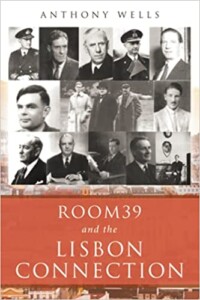Title: Room39 and the Lisbon Connection
Author: Anthony Wells
Publisher: Xlibris US
ISBN: 1664178872
Pages: 246
Genre: Historical Fiction
Reviewed By: Dan MacIntosh
Pacific Book Review
The concept for author Anthony Wells’ book, Room39, and the Lisbon Connection, is fascinating because it details the real-life experiences of Ian Fleming, who wrote the books that inspired the James Bond movie series. Therefore, these are mostly non-fiction spy stories about real wartime activities, involving real people. It’s also told from a British point of view, as the writer Anthony Wells is a Brit himself, and knows many of the people in this story. However, Wells did not know Fleming. Nevertheless, he does a fine job of getting inside the head of one of the most famous modern writers.
You might assume the flashy, womanizing Bond character was patterned after Fleming, but you’d be wrong. That honor goes to William Stephenson, who Wells describes as “a Canadian soldier, airman, businessman, inventor and spymaster.” Yep, Mr. Cool was actually a Canadian! With that said, though, Fleming is no dullard in this historical fiction book. He gets a beautiful girl, and also kills a Nazi, so he is not unlike James Bond in some respects. One Bond characteristic Wells overdoes just a bit much, however, is the way Bond likes his martinis – “shaken, not stirred.” It’s one of those famous lines even a non-Bond film fan can quote. However, Fleming’s character says these words multiple times, although we (the readers) pick up on it the first time. Every time after that is, well, unnecessary.
Readers should also be forewarned that Wells’ book is not nearly as action packed as a typical James Bond film. In fact, there isn’t any really sexy violence until about three quarters into the book. It should be noted that this is historical fiction, with strong emphasis on the ‘historical’ in its description. Wells has worked for British and U.S. Intelligence and is a certifiable military historian. This story is set during World War II, and concerns Hitler’s possible plans to invade neutral Portugal. Much of its story takes place in England, Switzerland and – toward the story’s end – the United States.
One of this book’s most fascinating sections is when a meeting between FDR and Winston Churchill was secretly arranged. This was before Pearl Harbor, and prior to the U.S. entering World War II. Even before the U.S. fought against the Japanese and Germans, England and the U.S. were planning how to defeat the Nazis. This was kept hush-hush, however, because the U.S. was not ‘officially’ in the war yet, and such a meeting would have put the U.S. president in hot water had this news gotten out to the press.
Wells’ description of spy work is not as sexy as how it’s presented in the movies. There aren’t any cool, sci-fi gadgets or fast foreign sports cars described in this book. Instead, a lot of secretive high-level meetings are detailed. In other words, spy work is described how it (mostly) really is, rather than the way we want to picture it in our wildest imaginations.
After reading this book, it’s easier to imagine how Ian Fleming was able to so accurately write about the spy game. He had close access to the some of the most powerful men involved in World War II, so his personal experiences could be more naturally fictionalized.
However, if you’re expecting to live out your sexy male lead movie fantasies through the real-life Ian Fleming, you may be in for a disappointment. This is more of a book about a pivotal point during War, which just happened to incorporate a few spies. Anthony Wells has a vast amount of knowledge, which he shares with his readers. He didn’t live out a movie; he lived out real life, after all. Watch James Bond movies for the action-packed thrills but read Anthony Wells’ Room39 and the Lisbon Connection for its accurate history.


